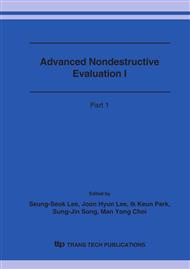p.957
p.963
p.968
p.972
p.978
p.984
p.988
p.992
p.996
Fabrication of a 40 MHz Single Element Ultrasonic Transducer Using a PMN-PT Single Crystal
Abstract:
PMN-PT, a piezoelectric single crystal, has been known to be a better material for transducer arrays due to its high electromechanical coupling coefficient (k33) and high dielectric and piezoelectric constants. It may also be good even for high frequency single element transducers using relatively high kt and low attenuation and velocity dispersion. However, it’s challenging to fabricate high frequency transducers using PMN-PT since it is easily breakable and requires small area and thickness of the transducer. A KLM model was used to simulate a 40 MHz single element transducer including 2 matching layers and a conductive backing. The simulation showed that the PMN-PT transducer turned out to be better in sensitivity and bandwidth than a 40 MHz LiNbO3 transducer. A 40 MHz PMN-29%PT transducer was fabricated and the pulse echo signals were obtained and analyzed. Its sensitivity was found to be –48 dB and –6dB bandwidth was about 48 %.
Info:
Periodical:
Pages:
978-983
Citation:
Online since:
October 2006
Authors:
Price:
Сopyright:
© 2006 Trans Tech Publications Ltd. All Rights Reserved
Share:
Citation:


